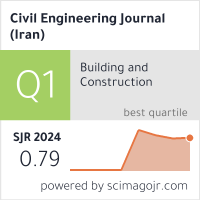A Study on the Quality of Campus Landscape on Students' Attendance at the University Campus
Downloads
Considering the expansion of higher education program in Iran to meet the needs of youth in recent years, there have been many institutes of higher education in closed spaces. This need is balanced now and it is time to highlight the importance of the impact of open spaces on higher education and improving its quality. The purpose of this study is to review landscape designing theories in University of Bojnord and investigating the role of these components in students' attendance in the university environment. The ultimate goal is to extract and prioritize the desirability factors of the open spaces of campus and the students' attendance at the university. -The findings of the extraction have been analyzed based on the access to landscape design patterns. It is conducted by designing a visual questionnaire based on the components of landscape desirability such as understanding, exploration, compatible with the desire for participation and relaxation and enjoyment of the landscape. The questionnaire was given to 55 Students of University of Bojnord. The statistical population was all students of University of Bojnord. The sampling method was random clustering from the faculties of based on their gender and major. The data was stored, analyzed and processed in SPSS software. Data analysis shows the priority of the main factors of the desirability of open spaces on campus. The landscape desirability of Bojnurd University and students' attendance at university is low and it requires a serious review of the architectural design of the university landscape.
Downloads
[2] Dober, Richard P, "Campus Landscape" ,Canada , John Wiley & sons, pp3. (July 2000). ISBN: 978-0-471-353560|
[3] Sharghi. A "The effect of the quality of campus landscape architecture on its educational application", Bagh Nazar, Research Center for Architecture and Urban Design, Eighth issue, (2011), Eighth Year, Fall, p. 51-62.
[4] Azemati, "Designing educational spaces with an emphasis on the desirability of open spaces", Master's Thesis for Architectural Engineering, Shahid Rajaee Tarbiat Modarres University (2012).
[5] Berman, Marc G., John Jonides, and Stephen Kaplan. "The Cognitive Benefits of Interacting With Nature.” Psychological Science 19, no. 12 (December 2008): 1207–1212. doi:10.1111/j.1467-9280.2008.02225.x.
[6] Pearson, David G., and Tony Craig. "The Great Outdoors? Exploring the Mental Health Benefits of Natural Environments.” Frontiers in Psychology 5 (October 21, 2014). doi:10.3389/fpsyg.2014.01178.
[7] Kaplan, Rachel, Stephen Kaplan, and Robert Ryan. With people in mind: Design and management of everyday nature. Island Press, 1998.
[8] Abu-Ghazzeh, Tawfiq M. "Communicating Behavioral Research to Campus Design.” Environment and Behavior 31, no. 6 (November 1999): 764–804. doi:10.1177/00139169921972344.
[9] Dalton, Linda C., Amir H. Hajrasouliha, and William W. Riggs. "State of the Art in Planning for College and University Campuses: Site Planning and Beyond.” Journal of the American Planning Association 84, no. 2 (April 3, 2018): 145–161. doi:10.1080/01944363.2018.1435300.
[10] Gorgati, Vinicius, and Pablo Savid-Buteler. "Why campus matters: Reflecting on models of the future campus within a new paradigm for campus living and learning." Planning for Higher Education 44, no. 3 (2016): 18.
[11] Haggans, Michael. "The 21st-century campus." Planning for Higher Education 44, no. 3 (2016): 1.
[12] Hajrasouliha, Amir. "Campus Score: Measuring University Campus Qualities.” Landscape and Urban Planning 158 (February 2017): 166–176. doi:10.1016/j.landurbplan.2016.10.007.
[13] Gifford, Robert. Environmental psychology: Principles and practice. Colville, WA: Optimal books, 2007. ISBN: 0993771904.
[14] Mortazavi, Sh. "Educational spaces from psychological aspect of the environment". Tehran: SAMT Publications, (1997).
[15] Pintrich, Paul R. "A Conceptual Framework for Assessing Motivation and Self-Regulated Learning in College Students.” Educational Psychology Review 16, no. 4 (December 2004): 385–407. doi:10.1007/s10648-004-0006-x.
[16] Azevedo, Roger. "Defining and Measuring Engagement and Learning in Science: Conceptual, Theoretical, Methodological, and Analytical Issues.” Educational Psychologist 50, no. 1 (January 2, 2015): 84–94. doi:10.1080/00461520.2015.1004069.
[17] Hipp, J. Aaron, Gowri Betrabet Gulwadi, Susana Alves, and Sonia Sequeira. "The Relationship Between Perceived Greenness and Perceived Restorativeness of University Campuses and Student-Reported Quality of Life.” Environment and Behavior 48, no. 10 (July 28, 2016): 1292–1308. doi:10.1177/0013916515598200.
[18] Tennessen, Carolyn M., and Bernadine Cimprich. "Views to Nature: Effects on Attention.” Journal of Environmental Psychology 15, no. 1 (March 1995): 77–85. doi:10.1016/0272-4944(95)90016-0.
[19] Information of University of Bojnord site and campus is taken from report of the studies of the university building plans office, (2014).
[20] Zarghami Esmaeil, Azemati Saeid, "An Investigation of the open spaces desirability of campus in students' viewpoint", Journal of Educational Technology, Volume 7, Issue 4, Summer p. 287-296, (2013).
- Authors retain all copyrights. It is noticeable that authors will not be forced to sign any copyright transfer agreements.
- This work (including HTML and PDF Files) is licensed under a Creative Commons Attribution 4.0 International License.![]()















